Hydrangea Limelight: description, photo, cultivation, planting, treatment of diseases and prevention
Limelight hydrangea variety was bred by Dutch breeder of Boskoop company Peter Zweinenburg in 1986. He used different subspecies of paniculata until he got a plant with large inflorescences of a delicate lemon color, acquiring a red-pink hue by autumn. Patented after performance improvement in 2002.
- Description of the variety
- Growing conditions
- Lighting
- Temperature and humidity
- Landing features
- Timing
- Site selection and preparation
- Selection and preparation of planting material
- Landing technology
- Care rules
- Watering mode
- Top dressing
- Preparing for winter
- Diseases and pests: treatment and prevention
- Landscape use
- Gardeners reviews
- Useful videos
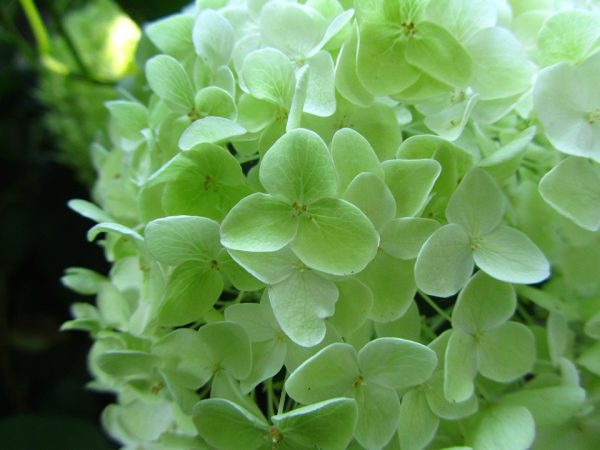
Hydrangea limelight planting and care
Description of the variety
Limelight, or Lemon light (Lime light) - a variety of panicle hydrangea, which has become widespread among flower growers in the United States and Europe. The name in Latin is hydrangea paniculata Limelight. It is especially popular in North America, where it is highly valued for its unpretentiousness, excellent frost resistance and elegant appearance. There is a compact subspecies of Little Lime.
In general, the plant is similar to the Grandiflora cultivar. Distinctive features are:
- straighter, vertically oriented panicles on strong, multi-flowered peduncles;
- unique light green sepals (in Grandiflora they are white);
- large petals;
- earlier flowering relative to other panicle hydrangeas (one month earlier than Grandiflora).
Limelight forms a dense (up to 14 branches) perennial, rounded shrub with evenly distributed stems. Plant height - 1.8-2.4 m, width - 2.3-4 m.Lateral branches with a diameter of 4.5-5 mm, a length of 0.6-1.5 m.Row spacing - 3-3.5 cm The stiff stems are smooth, young shoots are pubescent.
Leaves are ovate, opposite, persist for a long time on the branches. Length - 8.5-10 cm. Width - 4-5.5 cm. The color is deep green, slightly lighter below, reddening by winter. On average, there are 25 leaves on the stem.
Single star-shaped flowers with a diameter of 2.7-4.7 mm are densely located on the terminal pyramidal panicles with large spectacular sepals. The aroma is insignificant. In temperate latitudes, hydrangea blooms from mid-July to mid-October. But even after the onset of winter, it retains its decorative appearance for a long time. Cut flowers last up to 8 weeks.
The average height of paniculate inflorescences is 15-25 cm; specimens up to 30 cm are found. The diameter is 12-18 cm. There can be 850-1200 flowers on the branch. The color of the petals at the beginning of flowering is lime green, later light lemon, creamy white, by autumn it becomes greenish-purple and later - pink-red.
Growing conditions
Limelight has a tendency to grow outdoors, so pruning every year is recommended. Larger flower panicles can be obtained by thinning plants to 5-10 primary shoots.
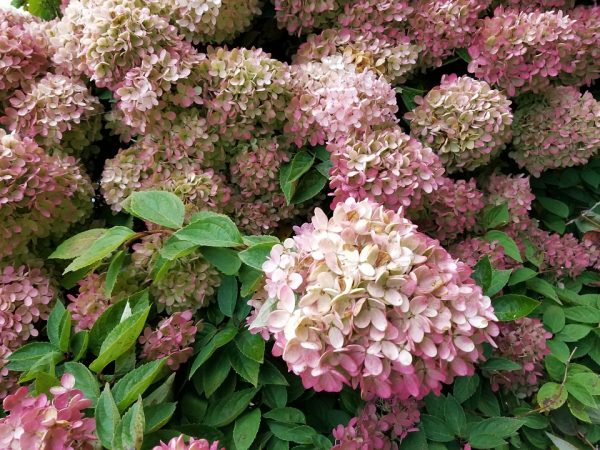
Hydrangea paniculata hydrangea paniculata limelight
Lighting
Paniculate hydrangeas, unlike treelike ones, do not really like full sun. Therefore, the landing site should be chosen slightly shaded.It is good if bushes or low trees grow at a distance (but not closer than 2 m), or there is a fence made of not tightly fitted picket fence. With an excess of ultraviolet light, the zest of the variety is lost - the lemon flowers fade and become whitish.
Full shadow is also not the best place. The bush will grow well, but bloom is much worse than expected. In more northern regions (zone 4 of winter hardiness), planting in the open sun is preferable, provided that it is protected from the wind.
Temperature and humidity
Typical temperatures in central and southern Russia are quite comfortable for the plant. Ideally, they should be between 20-26˚C. But even in a cool summer, the plant will not wither. Hydrangea Limelight is one of the most winter-hardy in the entire family. There are cases when it is revived, having survived 35-degree frosts.
Hortensiae love moisture and feel confident in humid climates. If the weather is stable and warm and dry, in addition to watering, it is useful to spray the bushes with water in the evening after sunset. When growing in tubs at home - moisten the leaves from the spray bottle regularly.
Landing features
Hydrangea paniculata prefers humus-rich, light, acidic soils. It is great - if there is a loam layer under the bottom. It will retain moisture. Cannot be planted on calcareous soil.
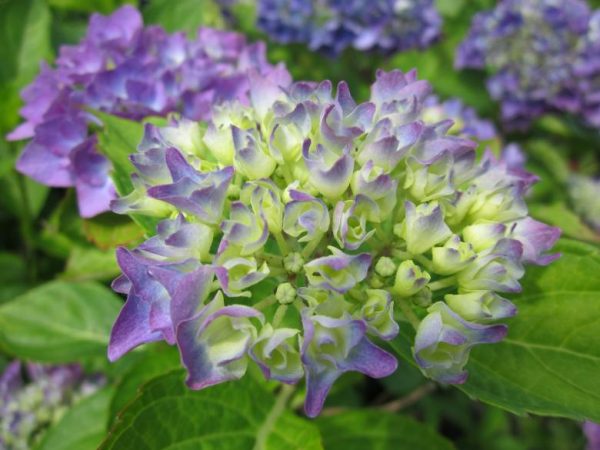
Hydrangea paniculata limelight
Timing
Most often, plants grown in container nurseries are planted, which have a well-developed root system. Such specimens can be planted all year round, except for the time when the ground is frozen. Bare-rooted plants (hedge shrubs) are planted only in fall or early spring.
Bushes purchased from nurseries, wrapped in burlap, are good for planting in the fall. Usually they manage to take root even before the onset of winter, and already rooted ones enter the new season. This option is good in that it helps to avoid the danger of drying out in the event of a hot spring and summer poor for rains.
Site selection and preparation
Before preparing the soil for planting plants in open ground, it is necessary to remove weeds near the hole. Perennials such as wheatgrass, dandelion or plantain compete with the planted hydrangea for food and moisture. If this is not done ahead of time, their roots will intertwine, and it will be more difficult to get rid of weeds.
The planting hole should be of the appropriate size - usually it is made twice as large as the earthen lump of the plant. The top layer of the soil is always more fertile than the bottom layer, devoid of many trace elements. Therefore, the latter, consisting mainly of sand and clay, must be additionally fertilized.
If the excavated soil from the lower horizon is "empty", sandy, through which water easily leaves, it is made heavier and enriched. To do this, mix in half with compost or fertile garden soil.
If, on the contrary, the soil is heavy and water stagnates in it, then it must be lightened. To do this, add river, or coarse sifted sand. But it is better to use vermiculite or its analogs - this natural mineral does not cake, does not wash out, does not rot, does not decompose, does not react with alkalis and soil acids. It is sterile, of no interest to microorganisms, molds and rodents, it contains no heavy metals and toxins. At the same time, vermiculite contains calcium, iron, aluminum, magnesium, which are so necessary for hydrangeas.
In the case of completely impermeable clay or silty soil, the bottom of the planting pit should be loosened well and mixed with sand or gravel. This action will allow at least partially to divert water from the planting pit, which would otherwise turn into a pot without drainage holes. If the soil is very dense, it will be useful to loosen the walls of the planting pit as well.
Selection and preparation of planting material
Only healthy seedlings are chosen for planting. With plants purchased on the side, dangerous diseases and pests can be brought into the site.The juicy green color of the foliage and young shoots will tell a lot about the state of the hydrangea. If the greenery has dark spots, mold, incomprehensible growths, or, on the contrary, discolored areas, such a plant is most likely painful. If the roots are without soil, you need to inspect them for rot.
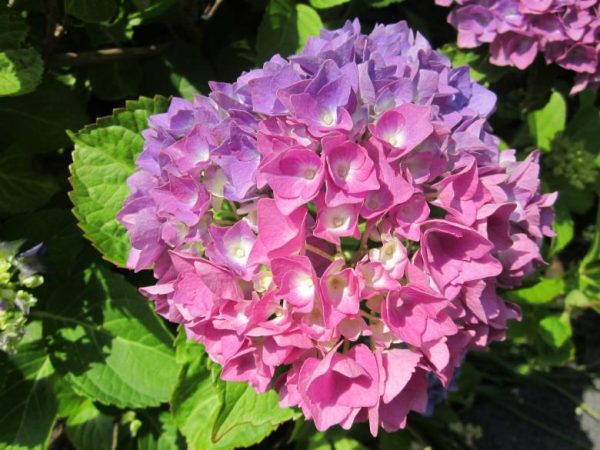
Hydrangea paniculata limelight photo
If the seedling is in a container, the plant is carefully removed so as not to damage the earthen ball with the root system. Hydrangea has thin roots, so they are easily damaged by mechanical stress. It is not necessary to pull the seedling out of the container forcibly by the aerial part. A large package must be carefully cut, a small one should be poured with water, turned over and lightly tapped on the bottom.
If the roots are twisted and form a tight ball, the lower part must be cut off with a secateurs, and those that remain, gently straighten. This will make it easier for the roots to penetrate the soil.
Attention! It happens that the plant in the container is overdried. In this case, you need to soak the lump in a bucket of water for a few minutes before planting so that it is well saturated. But this procedure does not replace subsequent watering after planting.
Landing technology
Having stepped back from the nearest tree, fence or wall of the building at least 2-3 meters, they dig a hole. It doesn't matter if you plant a formed bush or a small stalk, it should be medium in size in order to equip drainage. Usually a hole is made 50x50x50 cm in size.
At the bottom, drainage from scrap materials is equipped with a layer of 10-20 cm. A battle of bricks and ceramics, coarse gravel and river pebbles, but it is better to put expanded clay or clay balls. Some gardeners use organic materials (peat, moss, sawdust) mixed with sand, but they will rot over time and moisture removal will deteriorate. Hydrangeas grow better on acidic soils, so sour peat from raised bogs is useful on top of the drainage.
Next, the pit is half filled with the prepared substrate, a seedling is placed, the roots are straightened and sprinkled. Spill with water (1-2 buckets are enough) and again fill up the earth. They tamp and watered well again. If necessary, the seedling is tied to a peg driven in next to it.
Important! The root collar after planting should not be covered with earth.
The well is mulched after watering. The protective layer protects the shallow roots from drying out. It is useful to use coniferous sawdust, needles, peat as mulch - these materials contribute to soil acidification.
Care rules
Limelight is not picky about care. It is a strong, healthy plant that survives well in a garden and flower garden. The most important thing is to plant it correctly, at least sometimes to feed it and do not forget to water it in a drought.
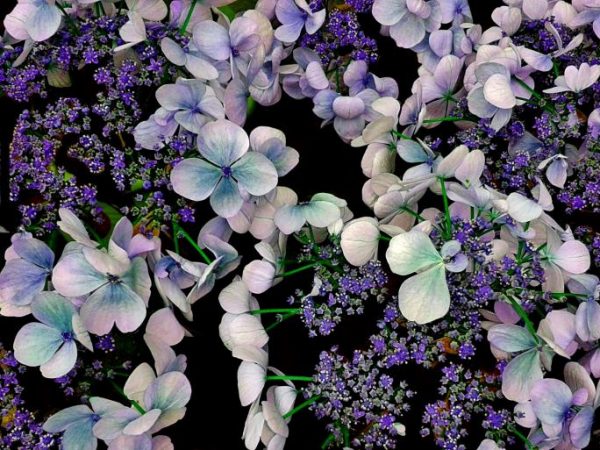
Hydrangea paniculata limelight
Flowering occurs on young shoots of the new season, so pruning is carried out as needed from the end of winter to the beginning of sap flow in early spring. They remove frost-damaged, sick, crooked and simply unnecessary branches.
Watering mode
Hydrangea likes to keep the soil in a slightly moist state. With a lack of rain, the bush must be additionally watered. The norm is at least 20-40 liters per week, depending on the age of the plant. In drought, the intensity of watering is increased.
Top dressing
Hydrangea is the flower that is responsive to feeding. In the spring, when the buds began to swell, organic fertilizers supplemented with nitrogen and potassium are used. At the beginning of budding, the plant needs more potassium and phosphorus. The usual superphosphate is enough.
By the beginning of flowering in the first half of July, complex mineral feeding will be useful. The mixtures "Agricola", "Kemira flower" and the like are well recommended. At the beginning and end of August, organic matter is used as an additional care measure: urea, a solution of mullein or chicken droppings, nettle infusion.
Preparing for winter
In the south and in temperate latitudes, the root zone is mulched for the winter.It is advisable that the mulch does not cover the near-stem zone, but is at a distance of 5-10 cm from the stems. In the northern regions, it is advisable to cover the plant. If the height of the bush is large, it may need to be pruned. The shelter is made of covering material, or of straw (hay, leaf litter), held by a net.
Diseases and pests: treatment and prevention
Hydrangea Limelight stands out for its strong immune system. It is rarely affected by ticks and aphids, as well as bacterial and fungal diseases. With regular waterlogging and growing in the shade, the following diseases can develop:
| Problem | Treatment | Prophylaxis |
| Rust | Fungal disease is treated with strong fungicides: "Ordan", "Falcon", "Ordan". | Avoid an excess of nitrogen in the soil, thin out the planting. Feed on time. |
| Leaf spot | Caused by many factors. The complex effect of copper preparations (copper sulfate, copper oxychloride) in tandem with fungicides ("Oxyhom", "Phtalan", "Abiga-PIK" and others) helps well. With a bacterial pathogen, "Fitosparin" is used. The damaged parts must be burned. | Seasonal treatment with Bordeaux liquid |
| Bacterial wilting | The infection is carried by pests. Their number is regulated by insecticidal preparations (Aktellik, Aktara, Arrivo, Bi-58, Inta-Vir, etc.) | Remove plant debris in time, especially the pumpkin family. |
| Mold | Fungal diseases are treated with fungicides. | Avoid waterlogging, make drainage when planting, thin out thickened plantings. |
Landscape use
Limelight is a versatile variety. It looks equally impressive in single plantings in the middle of the lawn and in large tubs at least 80-90 cm wide, as well as as group plantings in hedges and curbs. It is used to decorate sunny meadows in forested areas and botanical gardens. It goes well with "colored" hydrangeas of other subspecies and ornamental shrubs.
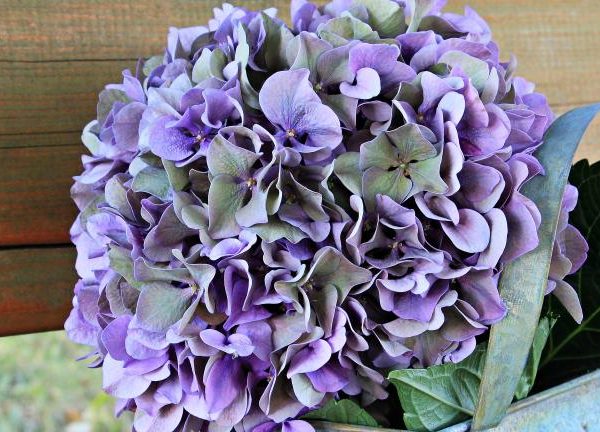
Hydrangea limelight photo and description
The bushes look very impressive in the standard form, resembling small tropical trees, or plantings of jasmine or white lilac, only with large brushes. It is difficult to form such a shape on your own. It is easier to buy a hydrangea on a stem in a nursery or a reputable flower shop.
Gardeners reviews
Despite the apparent simplicity, people note the high decorative qualities of the plant. If conditions are optimal, the flowers at the initial stage of flowering acquire a very beautiful, not bright, but saturated green color, reminiscent of lime peel. Then the petals brighten, starting from the bottom of the panicles, and by autumn they acquire red hues, which persist even after drying.
The bush itself is also interesting. It is quite large, sometimes taller than human growth, but not loose. The slender side branches are evenly spaced apart and stretch upward, and do not droop, like many others. Of course, with thickened border plantings, in which no pruning is done, this quality is leveled.
Also, gardeners note the vitality of the plant in the open field. They can stand dug out for weeks (but with an earthen clod), and after planting, take root in a new place. After severe frosts, branches may die, but the root system, as a rule, survives and starts up new shoots in the spring.

